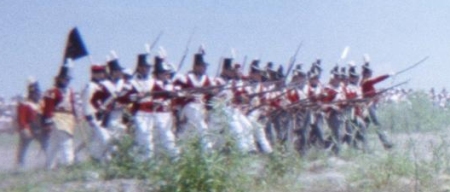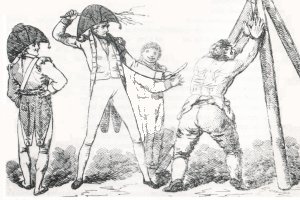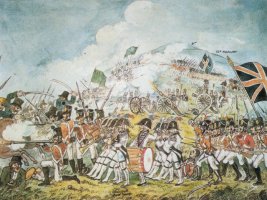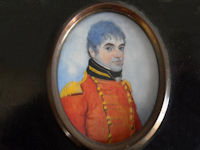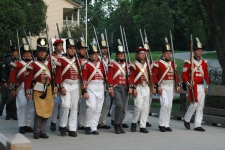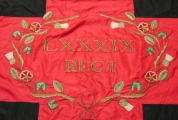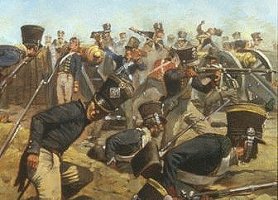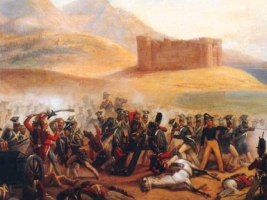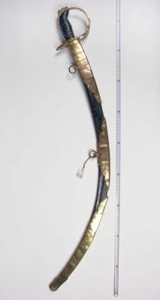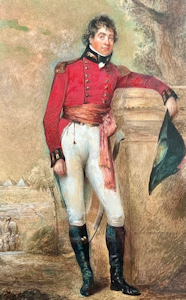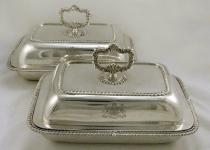Andrew Thomas Blayney
11th Lord BlayneyBorn 30 Nov 1770 in Ireland
Baron from 2 Apr 1784 [62]
Died 8 Apr 1834Title: Lieutenant-General,
Lord Blayney, Baron of Monaghan
[Creation: July 29, 1621, 19 James I]See Ancestry.
See Heraldry.
Go to [Descendancy]
Andrew inherited the Title of Lord Blayney, Baron of Monaghan in 1784, on the death of his brother Cadwallader Davis and ruled for fifty years. [88]
He entered the army in Nov 1789 as an Ensign (32nd Regiment), making Lieutenant in 1791 (41st Reg), Captain in 1792 (38th Reg) and Major in 1794 in the 89th Reg (partly raised in Ireland by himself), serving with them for 15 years. [436]
Andrew Blayney He served in Flanders and the retreat through Holland in 1794-5 "distinguishing himself in every encounter" [85a] [436], particularly at Boxtel. It was Lord Blayney's and his 89th Regiment's resistance to surrender (as recommended by the Hessian General Duering) at Boxtel which prevented this retreat from being a rout, and most probably saving the whole of the Duke of York's army. [433] [487].
He then accompanied the regiment to the West Indies (driven back by a storm) and in 1796 was promoted to Lieutenant-Colonel. [89], [85a] [436]
After his foreign service, the now Lord Blayney returned in 1796 and married Lady Mabella Alexander, eldest daughter of James Alexander, Sheriff of co. Tyrone and 1st Earl of Caledon (b.1730, d.1796) and Anne Crawford (Craufurd) (d.1777) dau of James Craufurd of Craufurdsburn, on 5th July 1796 at Caledon House, Dublin [85], [115].
In the same year, Andrew established a Yeomanry corps in Castleblayney. According to the Connolly Association (pro Irish unity), the "wealthy landowner" Lord Blayney was present at the formation of the Protestant Ascendancy movement in September 1795 (which became the Orange Order) [86]. Given that he didn't return from foreign service until late 1796, this has to be questioned. Furthermore, even though he was a member of the aristocracy, he was at first regarded as a reformer both by the Irish radicals and by the administration which was deeply suspicious of him, see Blayney Reformer.
In 1797 Lord Blayney was involved in a celebrated duel, see Blayney's duel.
With the rise of the United Irishmen, Lord Blayney appeared to have a change of heart and moved from a supporter of parliamentary reform to one of repression of insurgency, according to the present Sinn Féin [89]. His proposal to Lord Carhampton and Thomas Pelham (Chief Secretary) to establish a "flying camp" or mobile military force was accepted and on 22 May, Blayney and his mobile force launched an offensive on the United Irishmen in the Glaslough district.
He wrote to the government "Nothing can be really effectual but retaliation in point of destroying property, burning houses and setting the inhabitants to the mercy of the elements, by which means you will either force them to action or make them surrender the arms." [89] The Insurrection Act, passed early in 1796 followed by the suspension of the Habeus Corpus Act for all of Ireland with a view to disarming Ulster resulted in repressive actions like house burnings and floggings in the Armagh and Tyrone regions. Some villages (such as Blackstaff in Farney) were completely destroyed). [89]
Army using flogging to obtain "rebel" names & arms"Rebel" defeat at Vinegar Hill 1798
[National Library of Ireland]Lord Blayney's mainly Orange yeomanry were involved in the so-called 'Stewartstown Affray' of 1797 where 9 Catholic are killed [88]. Andrew, however, warned of the excesses of the Orangemen, stating "Orangemen ought certainly to be shown some countenance, but under that cloke robbers and assassins will shelter themselves, and the most conspicuous who countence them will be held forward as their leaders." [10th June 1797] [416]
The Irish saw things differently - "The massacre of the Militia by Lord Blayney took place at Newmills. Apart from blaming different sides for starting the riot, the accounts seem to tally fairly well with each other; as to which party was responsible it would seem to be almost impossible to judge. Ultimately, it was the responsibility of the authorities who had encouraged sectarian hatred and violence. Lord Blayney emerges from the incident as a violent and barbarous character". [1650 p27]
The failed United Irishmen Revolution of 1798 followed.In 1798 he purchased the Lieutenant-Colonelcy of his old regiment, the 89th Regiment of Foot, becoming its commander and commanding one of the notorious "Flying Camps" responsible for suppressing the "insurgency" of the United Irishmen. The 89th came to be known as 'Blayney's Bloodhounds' (because of their untiring perseverance in hunting down Irish "rebels" in the same year). The regiment amalgamated with the 87th Foot in 1881 to form the Second Battalion of the Princess Victoria's Irish Fusiliers" [87], aka 2nd Battalion, Royal Irish Fusiliers.
Andrew Thomas, Lord Blayney "Lord Blaney" [Andrew] was wounded at the Battle of Vingar Hill 1798 [355] so was unlikely to have been involved in the post-battle cold-blooded slaughter of defeated "rebels". While it is noted that he received some criticism from Catholic writers, it is hard to be judgemental when he was also met "with public thanks from the Grand Juries of three separate counties" [488].
In 1799 the 89th were garrisoned at the newly captured Minorca following which Andrew commanded both the 89th and 90th in protecting Sicily then assisting Sir Alexander Ball in "reducing" Malta. He was involved with Suwarrow's Russian army on the Continent, and with Sir Ralph Abercromby's Egyptian expedition, being present at all the engagements, earning the praise of Lord Hutchinson and the command of both the 30th and his 89th in garrisoning Cairo after its surrender.
During the brief "Peace of Amiens" Andrew returned to Britain via Spain and France, and while in Paris was "introduced to Buonaparte" himself! [433]
89th Reenactment [480] 89th Regiment of Foot colours [480]
Andrew was subsequently involved in the recapture of the French West Indian Sugar Islands and the Dutch Cape of Good Hope colony, Lord Cathcart's useless expedition to Hanover (1805), and General Whitelocke's hare-brained plan to recapture Buenos Aires in (1807), when the British forces performed well despite the expedition being doomed from the start.An incident occurred on a march to Cape Town which restored Andrew's esteem to his troops. Apparently the men were quite "troublesome" and disgruntled after almost drowning in the Atlantic then suffering severe hunger and thirst after a forced landing. "A singular Hottentot woman, perfect in her shapes, happened to cross the parade; her derrierre projected so much that Lord Blayney was induced to place his hat on it, and the motion of the feather, added to that of the Hottentot, had so curious an effect on the soldiers as to create incessant laughter and good humor, so that they proceeded cheerfully on their march..." [433].
Andrew held the office of M.P. for Old Sarum between 1806 and 1807 [85].
After further service at the Cape of Good Hope, Andrew requested a transfer to the Penisular War, and was sent to Cadiz with the 89th and promoted to Major-General 1810. [85a]. He was taken prisoner when making a raid from Gibraltar into Spain in the same year and was kept prisoner for some years by the French government [88], returning to Ireland in 1815. Ironically, he was captured by a Colonel O'Callaghan who had been a prominent United Irishman who had escaped from Ireland after 1798 and who had joined the French army. It is said he insisted on Blayney being held to ransom for some of the United Irishmen who were in British prisons.
Andrew wrote a book on his experiences "Narrative of a Forced Journey through Spain and France as a Prisoner of War in the Years 1810 to 1814" [15], which was also published in German (1814) and in French (1815). A new French edition "L'Espagne en 1810 - Souvenirs d'un prisonnier de guerre anglais" has recently been published [479].
He gained the rank of Lieutenant-General in 1814.
Battle of Fuengirola His role in the multinational amphibious assault against French-held Fort Fuengirola, M laga in Spain on 14-15 Oct 1810 during the Peninsular War had been criticised as showing poor generalship [84], and the British troops of cowardice. However a recent review in the Journal of Military History exonerates him and blames factors outside his control such as "a bad plan devised by other leaders, fortuitous winds, faulty cooperation between the militarily less proficient Spanish and the often arrogant British, partial reliance upon an ethnic hodgepodge of Napoleonic deserters, slow communications, and, in particular, a lack of reconnaissance by Blayney's Gibraltar associates. Had Blayney in fact implemented the original scheme of merely pretending to assault the fort and then suddenly sailing off in order to seize M laga which the main Franco-Polish garrison would have left to relieve the post at Fuengirola, he would have been too weak to repel an enemy counterattack." [16]
A fairly full description of the defeat is available on line [88] where M. Ayala provides a somewhat critical review of "British Defeats" in his "British Superiority" article (previously called "British Bragging"). However, Lord Blayney is depicted as honourable (twice giving the Poles a chance to surrender) and let down by his allies. The main setbacks for Andrew were the capture of a Battery guarded by the Spaniards and the "foreign battalion" and the subsequent flight of "350 British, and 1,000 German and Spanish infantrymen" in the face of a furious musket attack by 200 Polish infantrymen. Andrew's courage isn't questioned... "Blayney fought to the end, before he was knocked to the ground and taken prisoner". He notes that "Blayney's saber is today in Poland, in the city of Krakow" (Czartoryski Museum, Krak w {Cracow}).
The Capture of LordBlayney
Blayney Sabre at
Czartoryski Museum, Kraków1820 Watercolour portrait [1678]
of Lt Gen A T BlayneyFar more favourable (for Andrew) and extensive accounts are available on-line at thepeerage.com/e342.htm [85a] and in John Philippart's "The Royal Military Calendar, Or Army Service and Commission Book" [433] where the causes for the loss are clearly identified as beyond Andrew's influence, namely bad advice, misinformation, bad weather but mostly lack of enthusiasm by his Spanish and German (deserter) allies. A little known success of the expedition was successful landing and disposing of 20,000 "stand of arms" to Spanish Guerillas who were then able to disrupt convoys and "had a powerful influence on the success of future operations." [433]
He was an original thinker, as demonstrated by his letter as a POW in Verdun, dated 10 July 1813, to his brother-in-law, the 2nd Earl of Caledon, revealing significant Social Darwinism as well a certain aristocratic arrogance and predudice. See The 11th Lord Blayney as an original thinker. He also agreed with Charles Herbert that fossil remains were indications of a "former world" [584] and on meeting him stated he was "never more gratified in his life" and that "your ideas of a world before this, and that our present globe is only a renovation of a former, are completely my own; but I never could explain or defend them as you have done".
During his captivity Lord Blayney was treated well as he had given his word not to escape, but his men were treated less well, including the theft of much of anything sent them from family. However Andrew manged to reclaim much of the money by a clever bet, see Blayney's race. He eventually became responsible for relief efforts by the British government for all prisoners-of-war held in France.
In 1815 Andrew commissioned a matching pair of Irish sterling silver George III covered entrees from the highly regarded Dublin silversmith William Nolan, engraved with Andrew's Coat of Arms. One of these was on sale on ebay for $2,500 (US).
Silver Entrees of Lord Blayney Andrew was apparently also a fairly heavy drinker, described as a "six-bottle" man and generally fit only for bed after dinner! [90]. However, a slightly different and human glimpse into his private life is recorded in the diary of John Ynyr Burges of Parkanaur, Castlecaulfeild, Co. Tyrone (PRONI, T/1282/1, pp. 19-20) provides a rare glimpse of Blayney Castle and its owner, whom Burges visited in 1825. See www.proni.gov.uk/records/private/blayney.htm#life
After his return from captivity in 1815 Lord Blayney obtained a seat in Parliament and by about 1825 was Rt Hon Lord Blayney. [06]. Andrew also had a portrait (see watercolour to the right) [1678].
By 1830 Lord Blayney had converted Castleblayney from a miserable village, where the roads from Armagh and Monaghan to Dublin met, into a respectable market town [18]. He developed some small local industries and built a courthouse, a markethouse, a Catholic Church (unusual for Protestant landlord/baron) and rebuilt the Church of Ireland, with alterations continuing for some time [17]. O'Flaherty noted that "in the eighteenth century the only place of Catholic worship [in Muckno] was an unroofed shack in the Caragartha bog, about two miles outside Castleblayney". He descibes the legend that Lord Blayney [11th] owed his life to Callaghan from Culoville [who fought in the French Army against the British and was assigned to look after Lord Blayney after his capture]. On meeting Callaghan back in Ireland Lord Blayney asked him if he could give him a token of his gratitude and Callaghan asked for a suitable site for a Catholic church and so in 1814 St Mary's Catholic Church was opened [1274]. The problem with this story is that Andrew didn't return from captivity until 1815. Before his military duties took him overseas, Andrew had even planned a canal between Dundalk and Castleblayney at the cost of £54,000. [500]
He pulled down the old castle and built the present house at CastleBlayney, which was greatly enlarged by the Hopes.
In 1832 he made an "Unhappy speach" in Parliament, published in the Newspapers with "still more unfortunate explanation, which made the matter worse" [707].
And when, like Lord Blayney, they can speak their desire,
They jump from the frying-pan into the fire.
Ultra Popinjay Esq (New Tory Guide -Letter II)Andrew died suddenly on 8 April 1834 at age 63 at Bilton's Hotel, Sackville Street, Dublin, County Dublin, Ireland. Buried at CastleBlayney.
He has an extensive biography in the Dictionary of National Biography. [83] [436] and also in John Philippart's "The Royal Military Calendar, Or Army Service and Commission Book" [433].
Descendancy: 1🎨 Andrew Thomas BLAYNEY b.30Nov1770; d.8Apr1832 (suddenly, in Dublin); bur. at CastleBlayney. He became the 11th Lord Blayney in 1784 on the death of his brother Cadwallader + Lady Mabella ALEXANDER b.7Aug1775 m.5July1796; d.4Mar1854 (eldest dau of James ALEXANDER, 1st Earl of Caledon and Anne Craufurd / Crawford) [86], [45] [445] 2 Cadwallader Davis BLAYNEY b.19Dec1802 d.18Jan1874 - the 12th and last Lord Blayney [see Cadwallader] 2 Ann(e) BLAYNEY (Hon); b.1882; m.20Nov1818 (Brit Embassy, Brussels); d.11Dec1882 + Admiral Charles GORDON R.N., C.B. (a Captain at the time of his marriage); b.1781; d.11Dec1882 Younger son of Francis Grant GORDON 3 Jane GORDON b~1821 (St Machet, France) +(1)Rev James Henry Scudamore BURR b.10Aug1816 (London); m.5Feb1840 (Tidenham, Glos.); d.1852 Son of General Daniel BURR of Aldermaston [665] 4 Henry BURR b.1841 (Tidenham) + Emily Ann FENTON b.1853 (Brentwood, Essex) 4 Anne BURR b.1842 (Tidenham) + Francis MOGGRIDGE b~1836 (Llandaff, Glamorgan); m.21Dec1865 (Bath, England) 4 Charles Scudamore BURR b.17Oct1845 (Dennil Hill, Glos.) +(2)
Rev Francis LEWIS J.P., D.L. of St Pierre, co Monmouth; b.4Jul1782 (Cepstow, Monmouthshire); m.7Jan1853 (his second marriage) +(3)Capt. Stewart Erskine ROLLAND of Dibden Lodge, Hythe, Southampton; m.4Jul1840 2 Elizabeth Harriet BLAYNEY (Hon); d.May1818 aged 17 at Weymouth 2 Charlotte Sophia BLAYNEY (Hon) b.1807 (Castleblayney, Ireland) [1221]; m.2Feb1833; dsp.5Aug1863 + Frederick ANGERSTEIN Esq [445]
